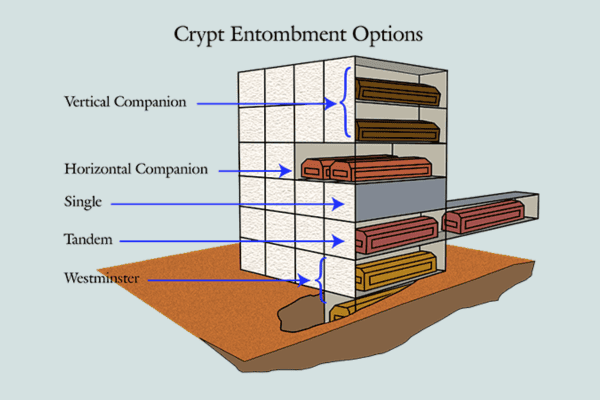Comparing Mausoleums and Crypts: The Differences Explained

End-of-life terminology is sometimes tricky. The meanings of words change – and some people misuse terms. Let’s compare mausoleums and crypts so you understand the precise word meanings as you design your family mausoleum.
Mausoleum vs. Crypt Entombment
Are the words mausoleum and crypt interchangeable? Here’s what you need to know about these two terms essential for private mausoleum design.
Definitions of “Mausoleum” and “Crypt”
According to the Oxford English Dictionary (OED), a mausoleum is defined as “a stately or imposing edifice erected as a commemorative burial place for or by a person of distinction.” The word originated from a specific burial chamber from ancient history – the magnificent tomb of Mausolus, one of the Seven Wonders of the Ancient World.
Since 1583, the word crypt has been used to describe “an underground cell, chamber, or vault; esp. one used as a burial place and typically lying beneath a church.” While a crypt is often a concrete or stone chamber – it can also be made with granite or other high-end materials.
What are mausoleum crypts?
You need to combine the previous definitions to understand the concept of a mausoleum crypt. A mausoleum crypt is a place for the body within a mausoleum. There are many different types and options for mausoleum crypts. Please allow us to break it down further so you can make plans for your vestibule mausoleum.
Types of Crypt Entombment
One of the many benefits of mausoleums is that you can design the structure to meet your family’s unique needs. However, you have many decisions to make when you opt for private above-ground entombment. One of the most essential decisions is the number and type of crypts you will include in your space. Here are some options to consider.

A diagram by Mount Pleasant Group showing various crypt entombment options.
Companion Crypts
You may choose to design a mausoleum with a single crypt. However, companion crypts are also common. Companion crypts can be placed side-by-side (horizontal), stacked above one another (vertical), or laid end-to-end. Sometimes, companion crypts have one shared label. However, you can choose to mark the graves separately if you wish.
Family Crypts
Some feel at peace knowing their family members will share a burial spot for all eternity. A family crypt is similar to a family burial plot at a cemetery.
Family mausoleums (sometimes called Westminster crypts) can be designed to accommodate the remains of several generations of family members. There may be individual labels for each of the dead – with one central monument celebrating the family name.
Columbarium Niches for Cremation Ash
As more people choose cremation, it’s important to know that mausoleums can be explicitly designed for cremated remains. There are many ways that ashes can be interred, but one common choice is a columbarium niche specifically designed to hold cremation urns.
Learn More About the Types of Mausoleums
Are you committed to above-ground burial? Forever Legacy is your go-to source in North America for private family mausoleums. We will walk you through the entire process, from choosing a fitting location to designing a beautiful memorial facility. We work with the best artisans, builders, and landscapers in this part of the world to create your own Taj Mahal mausoleum.
Contact Eternal Mausoleums by Forever Legacy today to request a consultation.
Key Takeaways About Designing Your Family Mausoleum
- A crypt is a part of a family mausoleum that holds a casket or urn.
- Companion crypts can accommodate two people.
- Family mausoleums can be designed to hold several generations of the same family.
